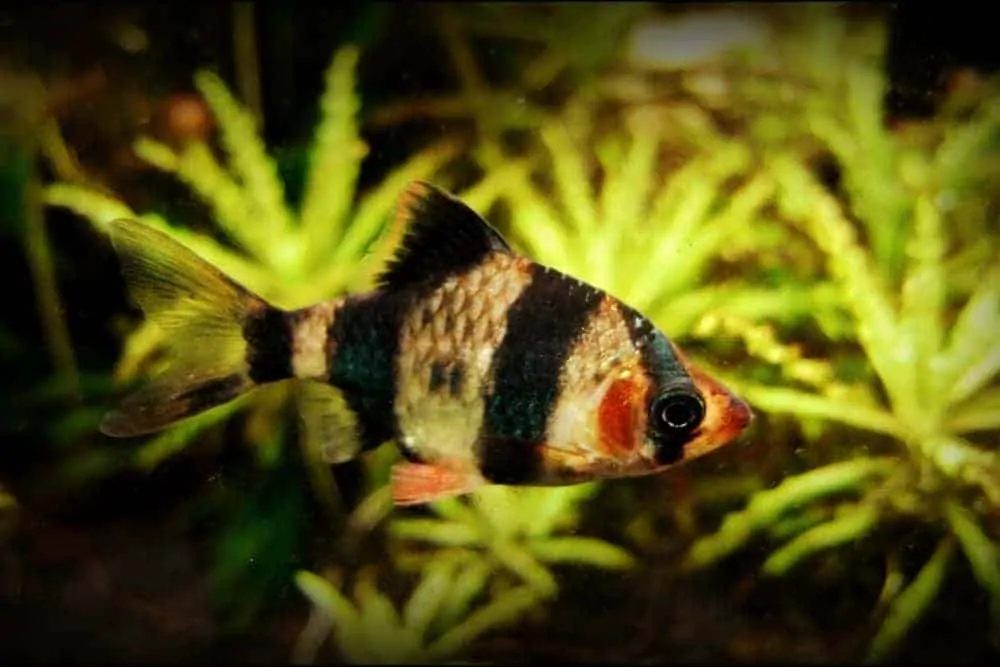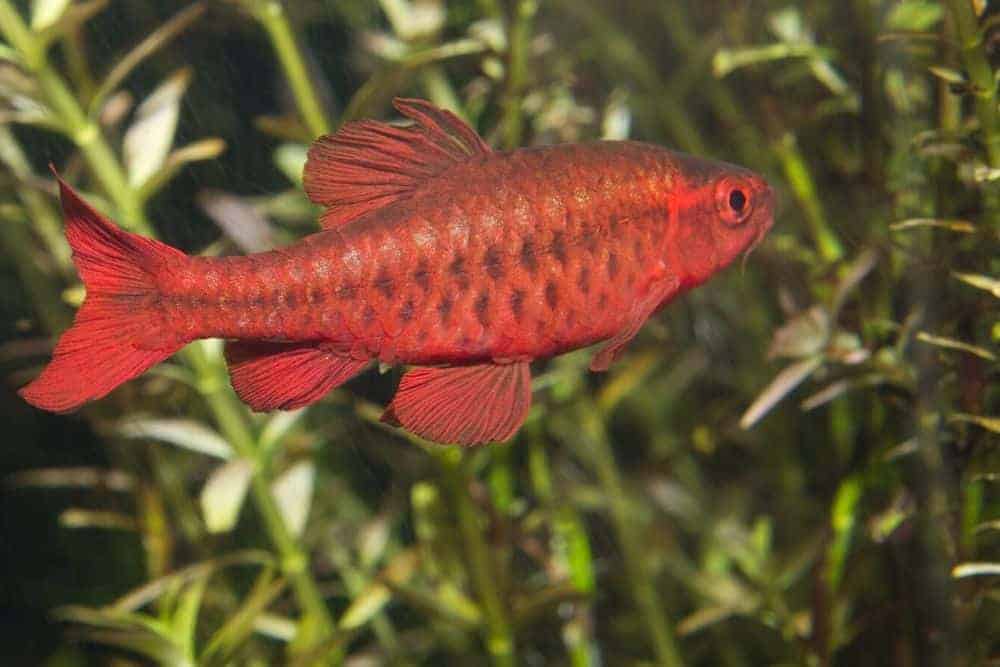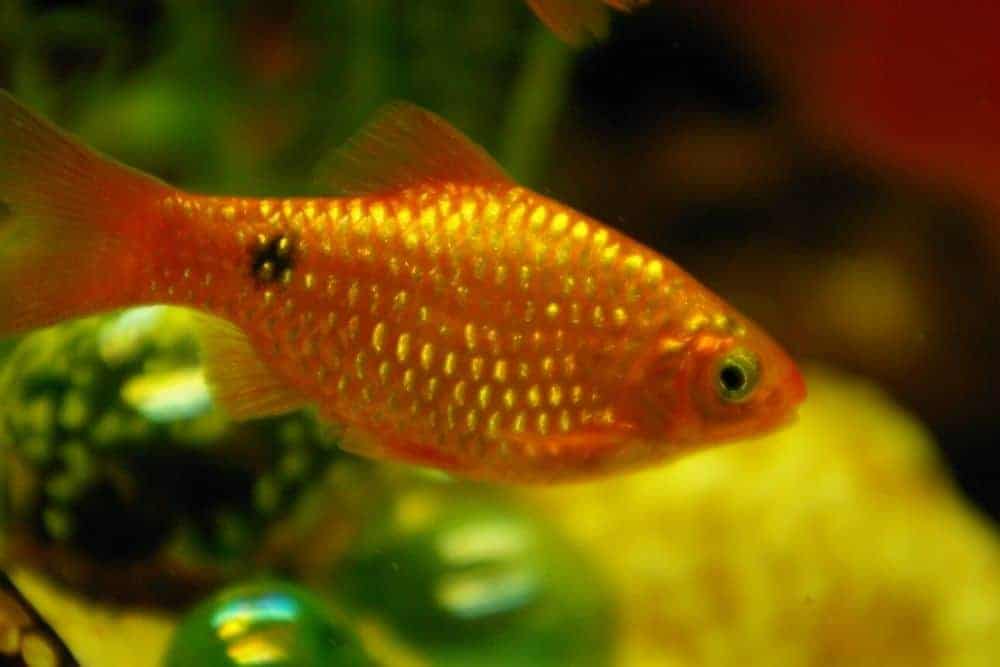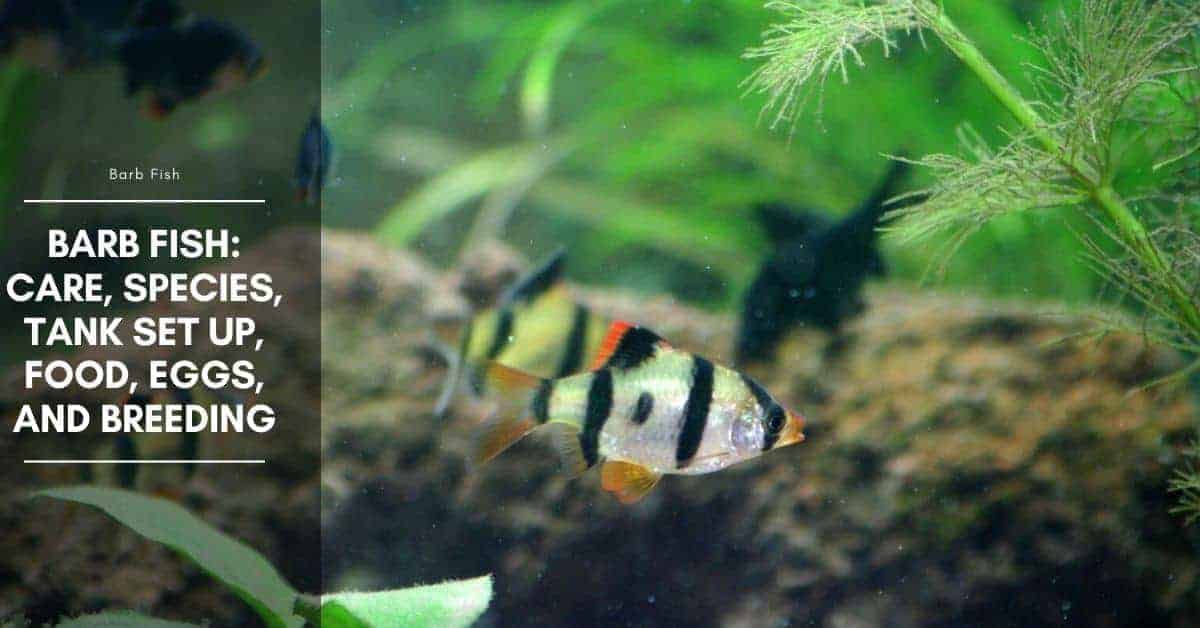Among the many virtues, the barb fish offers the amateur aquarist is its amenability to a wide variety of foods. Since barbs will eat almost anything offered to them, dry food, which is readily accepted, may be given several times a week.
Here are some of the foods that barb fish eat:
- Tubifex
- Earthworms
- Beef heart and liver
- Daphnia
- Brine shrimp
- Mosquito larvae
Tubifex
Excellent as a conditioning food that promotes the rapid growth of young barbs, Tubifex worms of a select grade are available in almost all pet shops and, if cared for properly, can be easily included in the barb’s diet. When purchased from a reliable source, there is little justification to condemn them as some do, as unclean.
Although Tubifex can be kept alive in a number of ways, perhaps the best method is to place them in a shallow enamel, glass – or plastic pan through which a fine stream of water constantly flows, purging them of any mud or silt. An alternate method is to keep them in a shallow pan with, perhaps, as little as an inch of water in the bottom to keep them moist. Flushing the worms with cold tap water several times a day freshens them and, simultaneously, beaks up the “community ball” into which they habitually group themselves. Pouring off the excess water then permits removal, of floating foreign matter or dead worms. The tray of worms must be kept in a cold place. During the hot summer months, the same procedure may be used if the Tubifex are kept in an uncovered pan in the refrigerator.
The Tubifex are always rinsed thoroughly before being fed to the fish by means of an ordinary cooking baster. The worm fragments are placed in water which is then sucked into the baster and fed to the barbs drop by drop.
Earthworms
An excellent barb food if still young and tender. Since the majority of fish, including barbs, like worms and tend to consume an excess of them, they may die from indigestion caused by gorging themselves on whole worms. It is therefore suggested that the worms be chopped up prior to being fed. A commonly used and inexpensive vegetable cutter can be used for cutting the worms to the proper length. This may be done on a soft pine board to prevent dulling the blade too quickly.
Since earthworms are difficult to maintain they are not overly practical for the aquarist who keeps many aquariums. However, earthworms are excellent for conditioning a small number of pairs of barbs for breeding.
Beef heart and liver
Containing a great many nutrients essential to good barb growth, beef heart and liver constitute a first-rate food on which most fish thrive. In fact, many state fish hatcheries use this for a large portion of the diet for their trout fingerlings.
When preparing beef heart for barb feeding, it is essential that all fat be cleaned off and all arteries removed with a sharp knife. The heart, and this applies to the liver also, is then cut into cubes, wrapped in wax paper, and placed in a refrigerator freezer compartment for storage until use.
Once frozen, the beef may be scraped off as flakes with a single-edged razor blade, or run through a small cheese grinder in order to obtain the proper size and consistency for the barbs. Since liver has a tendency to cloud water, it is unwise to overfeed it. Uneaten beef or liver should be immediately siphoned out before it begins to decay on the aquarium bottom.
Daphnia
Minute crustaceans resembling tiny crabs and frequently called “water fleas“, daphnia should be fed in moderation since the chitinous shell provides an excess amount of roughage. There are at least two forms that may be found in lakes and ponds: summer daphnia and winter daphnia. The former, featuring soft shells, is abundant during the spring and summer. Winter daphnia are hard-shelled and not all fish will eat them.
Almost invisible in their natural habitat because of their brown or reddish color, daphnia may be detected by placing a net of fine white material in the water against which they will sharply contrast. Heavy feeding of daphnia will necessitate more frequent cleaning of the filters because the water will take on a turbid appearance. It is suggested that they be used as an occasional treat rather than as a routine diet.
Brine shrimp
A vital part of the aquarium hobby, brine shrimp have made it possible, through their availability and low price, for aquarists to feed and raise many of the tropicals now gracing home aquariums. The value of this food in giving the fry of all tropicals the needed quick boost at birth is enormous.
Although newly-hatched brine shrimp may be fed to both adults and young, it is unwise to feed more than they will eat, since any accumulation of dead shrimp on the tank bottom will stimulate the growth of bacteria and infusoria normally present in all aquariums. Their resulting rapid proliferation will cause the tank water to turn cloudy.
Mosquito larvae
Probably the finest food for all species of tropical fish, mosquito larvae cost nothing since the aquarist may grow them himself. Fill several wide-mouth jars three-quarters full of water and add a few tablespoonfuls or either fresh or evaporated milk. Place the jars in a shady part of the backyard. Within a day the mixture will become foul and give rise to a rotting odor which is particularly attractive to egg-laden female mosquitoes. At night with a flashlight, it is frequently possible to observe the females depositing “egg rafts” on the surface of the mixture. As many as several dozen of these deposits may be made per evening.
Requiring approximately ten days to complete the cycle from egg stage to winged adult, the larvae are so tiny when hatched that they can be discovered only because of their jerking motions. At this stage, they may be fed to young fry whose size is approximately one-quarter to five-eighths of an inch long. If you wait a little longer, the comma-like wigglers will grow large enough to be fed to the adult barbs. But don’t wait too long or they will develop wings and fly away. This can be forestalled by covering the mouths of the jars with fine cheesecloth secured with a rubber band around the bottle’s neck.
Barb fish Facts
Barbs fish are members of the Carp family, they constitute an unusually large group and are indigenous to Europe, Africa, and Asia. Ideal for the amateur breeder, they are easy to maintain, are generally in plentiful supply, are not overly expensive while yet boasting the virtues of a variety of species, mix well in community aquariums and, generally, are both hardy and colorful.
The majority of barbs fish available from pet shops and pet departments originated in Asia. Now, however, within the last few years, African barbs have become available to both American and European aquarists. The most outstanding representative of this latter group is the Capoeta huhtaerti (Poll) which is, currently, not available owing to the political and military unrest in the Belgian Congo. However, with the cessation of hostilities, it is expected that shipments will again be resumed.
Another of the barb’s fascinations is the fact that there are still many species, especially in India and Africa, which have not yet been classified. Their complete classification is to be looked forward to since the Asiatic barbs are highly colorful and are shaded many hues of red.
API STRESS COAT Aquarium Water Conditioner 16-Ounce Bottle
29% OffAPI STRESS ZYME Freshwater and Saltwater Aquarium Cleaning Solution 1-Ounce Bottle
13% OffAPI ACCU-CLEAR Freshwater Aquarium Water Clarifier 4-Ounce Bottle
13% OffSince many barbs grow too large for the average home aquarium, this post will confine itself solely with those that are practical.
Large-scaled and silvery-sided, barbs vary in the number of barbels they possess, with some species having none and others two to four. Whisker-like, fleshy appendages located in the mouth area, the barbels are extremely sensitive and aid the specimen in searching out food, especially when it is located on the bottom of the tank. When the fish are quiet at night, the barbels are readily detectable, especially with the use of a small lamp or flashlight. The designation “barb”, of course, derives from a shortening of “barbel”.
Millions of these popular, readily-available species are raised annually in Florida fish farms, in independent local hatcheries, and by novice aquarists. Their ease of maintenance in the home aquarium makes them an ideal choice for breeding at home.
8 Popular types of barb fish
The genus Barbus contains around a thousand different species of which more than thirty are regularly available to the tropical fish hobbyist. Here are eight recommended for breeding by the novice.
Tiger Barb Fish – Barbus tetrazona

Incorrectly called Barbus sumatranus. Males have redder fins and slightly slimmer bodies. Although a tail nipper, they are extremely active and most beautiful when fully colored. They do best when kept in small schools of four or more. They are also available in an Albino color.
Cherry Barb Fish – Barbus titteya

A peaceful, quiet fish, easy to breed, easy to sex because the males, when mature, are wine-colored.
Ticto Barb – Barbus ticto
Active, easily bred. The males have more color in their dorsal fins.
Gold Barb – Barbus semifasciolatus
A golden mutation commonly, but incorrectly called Schuberti Barb is the most available. Very handsome when full grown. Easily bred.
Checkerboard Barb – Barbus oligolepsis
A very pretty fish when the males are fully grown. Sexing is easy because the females lack the brilliance of the male. This diminutive species is very easily bred.
Black Ruby Barb, or Niger Barb Barbus nigrofasciatus
During breeding time, the males are unquestionably among the handsomest of all fishes, presenting a never-to-be-forgotten sight. The male’s dorsal fin is black.
Barbus cummingi
Easily bred but exceptionally slow growing. The males, once they have assumed coloration, maintain it, having brilliant red fins.
Rosy Barb Fish – Barbus conchonius

Readily available and easy to breed. Usually fairly large as they are bred and reared in large pools on the Florida fish farms. Inexpensive. At breeding time, the males are exceptionally beautiful. The female lacks the black tip on the dorsal fin.
Barb Tank Set-Up
Since they are adaptable and of a gregarious nature, barbs can readily be kept in community tanks provided there is plenty of swimming room. Because of their high degree of physical activity, a 10-gallon tank, at least, is recommended. As for temperature, the proper range is from 72°F to 75°F. The tank should be kept in a sunny location and heavily planted.
There is, to some extent, a degree of variability where tank size is involved. The less-active Cherry Barbs Barbus titteya and Barbus oligolepsis are quite comfortable in a 10-gallon tank if the crowding is not excessive.
Those aquarists who decide to concentrate solely on barbs, or who choose to keep them in a separate tank, would do well to separate the sexes. Not infrequently, indiscriminately mixed barbs will spawn in community style, thereby causing a loss of selected spawns.
It is also wise to pre-condition the fishes for spawning and for community tank life by keeping them temporarily in a bare-bottomed tank with a selection of potted plants: Amazon swords or any of the larger Cryptocorynes. Since uneaten food or waste can be easily siphoned out and the water replaced, the result will be a high degree of cleanliness and health.
A considerable amount of detritus, as noted in the previous section will frequently work down into the gravel on the bottom of a fully equipped tank and cause hydrogen sulfide and other noxious gases to accumulate and endanger the piscine life. Also, a stripped-down tank of the type described permits a great deal of light to reach the barbs causing them to become deeply colored.
Changing the water
It must be remembered that, in maintaining tropical fishes artificially, the natural environment must be duplicated as closely as possible. Since barbs originate in tropical zones where the amount of rainfall is both high and recurring, frequent partial changing of the aquarium water becomes essential. The importance of this is often overlooked by beginner aquarists.
A partial change should be made every two weeks. Only by strict adherence to such a schedule can waste products be eliminated prior to their causing a toxic condition. It might be noted here that although the presence in the water of beneficial bacteria and protozoa, plus a constant filtration operation, help to maintain water purity and sweetness, beyond a certain point they are ineffective if not reinforced by additional techniques.
The signs of an oncoming toxic tank condition are unmistakable. The barbs refuse to eat. Then they become nervous and excitable, and the edges of their fins begin to rot. Final decomposition sets in rapidly.
Strangely enough – and this is what misleads many otherwise conscientious hobbyists – the water remains crystal clear. The extreme acid condition of the tank, caused by the decomposing waste products, can be detected only by a pH check.
The solution? An immediate and complete water change made in several stages to avert shock is absolutely vital.
The mechanics of water removal are as follows. A siphon which should be a permanent part of the aquarium equipment, consisting of plastic tubing one-half inch in diameter, or a piece of plastic garden hose, should be used. The length will be determined by two factors; the depth of the tank, and the distance from the tank to the receptacle for the discarded water.
To prevent the barbs from accidentally being caught up in the siphon action and sucked away, it is advisable to keep an index finger near the open end of the tube in order to plug it up quickly if a barb swims too close. Take time and care in performing this operation; it is essential that all debris be removed from the tank.
Another method which pays off to those who apply it, is to maintain a reservoir of preconditioned water over the tank. This simplifies the water changing process by siphoning the replacement liquid into the aquarium.
Another alternative is to use a plastic pail, jar, or other containers that can be easily hand-controlled. It is absolutely vital, of course, that the water temperature in both tank and reservoir be exactly the same (72°F to 75°F.) in order to avoid chilling the barbs.
The size of the reservoir of conditioning water, which is for emergency use as well as for water changing, depends on the amount of space available for it, and on the number of tanks the aquarist possesses. Storage containers can range from 5- gallon wide-mouth jars and unused aquariums to secondhand refrigerator liners (excellent for the purpose), and strong cardboard or wooden boxes lined with large plastic bags of the type used to ship fish.
The refrigerator liners are widely used by experienced breeders. Their value for water storage derives, primarily, from the inner enamel coating which permits them to be easily cleaned, and which does not react with water. Of minimal weight when empty, they can be moved and stored without effort and, both used and “seconds”, are economically priced.
Specifics of barb breeding
When selecting barbs for breeding, make it a practice to purchase only young specimens in numbers large enough to ensure several pairs. A minimum of twelve is suggested.
Many novices have the habit of wanting only the largest specimens of any breed in their tanks. This is fine, providing breeding is not the goal. However, if breeding is the goal, then young fish should be insisted on.
The primary reason for this is that young fish can adjust to local tank conditions more easily than mature ones. They can then be observed carefully during their growing period. Most barbs are easily sexed – the males are slimmer, have much more color and, in some species, are larger-finned.
If uncertain regarding the sex, the aquarist should place the fish in an aquarium of their own. At one end, there should be maintained a mass of plants in which, if both males and females are present, they can spawn. By observing closely, the hobbyist may be able to spot a pair spawning or a community spawn. If a pair, net the particular fish and separate them by placing them in other tanks of all-male and all-female barbs. Once a spawning pair is isolated, it is wise to spawn them frequently to prevent the female from becoming eggbound.
The breeding tank
In preparation, the breeding tank should be thoroughly cleaned and filled with clean, freshwater. After being allowed to age for twenty-four hours, a peat filter should be placed in the tank. Since freshwater contains an excess of dissolved gases, the twenty-four-hour wait eliminates those excess gas bubbles which otherwise would adhere to the glass wool in the peat filter and cause it to float.
To allow the leaching of humic acids from the peat, the water should again be allowed to filter for three or four days. It will then become crystal clear although slightly amber in color. Make sure the temperature is between 80°F and 85°F. since this higher-than-usual level increases the barbs’ desire to spawn. This entire process should be completed prior to introducing the fish to the breeding tank.
Protecting the eggs
Since barbs eat their spawn, methods must be devised to prevent this and to save as many eggs as possible. Large aquarium pebbles spread over the bottom of the tank will provide protective pockets and crevices into which the eggs can fall. Another approach involves spreading a layer of used peat (or peat which has been boiled to remove excess humic acid) over the bottom of the tank. This, too, will conceal fallen eggs.
Transferring the fry
Since 5-gallon aquariums are the most practical to use in the spawning of the majority of barbs, it is preferable, after one week of feeding, to transfer the fry to larger quarters containing fairly new water.
Siphon the water from the breeding tank, being careful not to siphon out any of the fry. When the water level is just a few inches from the bottom, and the fry are concentrated there, place the breeding tank into the larger one and slowly tip it on end until the fry swims out into their new home.
This procedure of fry-transfer should be repeated at a minimum of once a month, always using conditioned water. When the fry have grown to half an inch in length, they may then be carefully netted for placement in a new, clean tank. This procedure of systematic transfers ensures steady growth which, in the case of barbs, is generally slow. Another advantage is that it prevents the barbs from becoming stunted, although the correct diet plays an even more important part.
If regular transfers are impossible owing to peculiarities of the breeder’s setup, then, at least, half the old water must be siphoned out at a minimum of once a week and replaced with conditioned water.

Hi, my name is Sean, and I’m the primary writer on the site. I’m blogging mostly about freshwater and saltwater aquariums, fish, invertebrates, and plants. I’m experienced in the fishkeeping hobby for many years. Over the years I have kept many tanks, and have recently begun getting more serious in wanting to become a professional aquarist. All my knowledge comes from experience and reading forums and a lot of informative sites. In pursuit of becoming a professional, I also want to inspire as many people as I can to pick up this hobby and keep the public interest growing.
Read more about Sean.
Please join also my Facebook group.




















